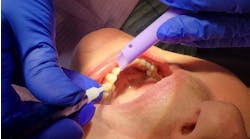Vaping and adolescents: Nobody knows where this is going
Are e-cigarettes a safe source of a nicotine high or is there danger in the air? The popularity of e-cigarettes and vaping is drastically on the rise in society, especially among teens and young adults. In recent months, our news feeds have been littered with stories related to the risks associated with e-cigarettes and vaping dangers.
I can smell a cigarette smoker when he or she is my chair, giving me the opportunity to begin a conversation about cessation. But I find it much more difficult to identify patients who vape due to a lack of odor. The lack of a pungent odor draws some users to electronic nicotine delivery devices (ENDS), while the sweet flavors and nicotine high appeals to others.
Higher risks to adolescents
There is a misconception among youth that e-cigarettes are harmless and pose no long-term risks. News stories and early studies are surfacing that identify the health risks posed to young people who vape, including delayed brain development and respiratory health, and an increased risk of addiction, poor impulse control, and mood disorders. (2) The concern with ENDS devices is there are no long-term studies to show the potential outcomes of continued use and its correlated side effects. Where e-cigarettes serve as a good alternative in smoking cessation for established smokers, e-cigarettes pose an risk to non-cigarette smokers who may have otherwise never been interested in nicotine. The risk of second and third-hand exposure is still in question as well.
Mint, mango, and blueberry cheesecake—the flavor options are endless, while the flavor of traditional cigarettes kept some teens from smoking. Manufacturers are not required to report the ingredients in e-cigarettes, and therefore we are not sure what is really in the liquid, and formulas vary among companies. The National Institute on Drug Abuse reports that 66% of teens report that they think there is only flavoring in e-cigarette liquid, 5.8% believe it contains marijuana, 13.2% believe it contains nicotine, 13.7% don’t know, and 1.3% report other ingredients. (1)
Recent studies demonstrate that teens are more likely to use e-cigarettes and vaping devices than they are cigarettes—9.5% and 3.6% of 8th graders report that they have used e-cigarettes and cigarettes respectively in a one-month period; 6.3% and 14% of 10th graders, and 11.4% and 16.2% of 12th graders reported that they used e-cigarettes and cigarettes, respectively, within a one-month period. (1) Some argue that the use of ENDS will help prevent teens from smoking later in life, however studies show 30% of teen e-cigarette users begin smoking cigarettes within six months, with twice as many boys as girls vaping. (1)
Juuling pods: Worse than a pack of cigarettes?
Juul devices, which look like a USB drive and are easy to conceal, are appealing to and popular with teens and young adults, making it difficult for parents and teachers to identify when teens are vaping. Teens are able to discreetly pack and use the device, as they appear to be handling just another USB drive. The Juul device does not work by heating liquid, as most e-cigarettes do. Instead, it heats pods that contain nicotine, propylene glycerol, glycerol flavoring, and nicotine salts. The device delivers high concentrations of nicotine quickly, with one report stating that the JUUL pod contains as much nicotine as one pack of cigarettes. (4)
Ingredients found in addition to the highly addictive nicotine in some ENDS devices include carcinogens and metal particles in the vapors and aerosols. The incidence of nicotine toxicity in children is increasing annually with the FDA taking notice of the risks and usage among our nation’s teens. In April 2018, the FDA issued a statement detailing planned steps to limit the appeal and use of ENDS devices to children and penalize companies that sell to children. (4) Seven of every ten teens report they are exposed to advertising for e-cigarettes in a given month. (1)
Vaping liquids may lack some of the toxic ingredients found in cigarettes, however, they do not come without risks. Reputable news sources have aired the story of an 18-year-old who developed severe respiratory distress after only three weeks of vaping use, likely due to the chemicals associated with vaping. The young lady was diagnosed with “wet lung,” requiring a ventilator and drainage tubes to release the liquid in her lungs. (3, 5) Additionally, the risks of nicotine toxicity and overdose are higher when vaping than when smoking cigarettes due to the concentration of nicotine in the vaping liquid of Juul pods. News stories and social media have been reporting stories of ENDS devices with defective batteries that have caused fires or explosions, occasionally resulting in injury. Time will tell what the effects of inhaling heated vapors have on the oral and systemic body systems.
Looking ahead
Communities and school programs to combat this trend and educate youth about the risks associated with vaping, and to educate parents and teachers of the signs to watch for in adolescents, are beginning. Teachers are banding together in groups, such as ShapeAmerica, to discuss methods to educate and reach out to students about challenges facing our children, including substance use and abuse. Businesses are beginning to ban the use of vaping devices within the premises as they have with cigarettes years before. Many ENDS users do not realize what the products may contain and the addictive properties that vaping can pose, especially among our youthful generations. Recognition and among the professionals in the dental practice and educating at risk patients can aid to establish not only good behaviors, it can also help reduce the risk developing life threating habits.
References
1. Teens and e-cigarettes. National Institute on Drug Abuse website. https://www.drugabuse.gov/related-topics/trends-statistics/infographics/teens-e-cigarettes. Updated February 2016.
2. Risks. Know the Risks: E-cigarettes and Young People website. https://e-cigarettes.surgeongeneral.gov/knowtherisks.html.
3. Welch A. Teen develops "wet lung" after vaping for 3 weeks. CBS News website. https://www.cbsnews.com/news/teen-develops-wet-lung-after-vaping-for-three-weeks/. Published May 17, 2018.
4. Statement from FDA Commissioner Scott Gottlieb, M.D., on new enforcement actions and a Youth Tobacco Prevention Plan to stop youth use of, and access to, JUUL and other e-cigarettes [news release]. White Oak, MD: US Food and Drug Administration; April 24, 2018. https://www.fda.gov/NewsEvents/Newsroom/PressAnnouncements/ucm605432.htm.
5. Sommerfeld CG, Weiner DJ, Nowalk A, Larkin A. Hypersensitivity pneumonitis and acute respiratory distress syndrome from e-cigarette use. Pediatrics. 2018;141(6). pii: e20163927. doi: 10.1542/peds.2016-3927.
Jamie Collins, RDH, is a clinical practicing hygienist in Idaho and Washington states. She has been in the dental field for nearly 20 years, both as an assistant and hygienist. With a passion for patient care, especially those with higher risk factors, Jamie enjoys sharing the tips and tricks of dental profession through speaking and writing. In addition to clinical practice Jamie is also an educator, has contributed to multiple textbooks and curriculum development, and contributes as a key opinion leader. Jamie can be contacted at [email protected].







